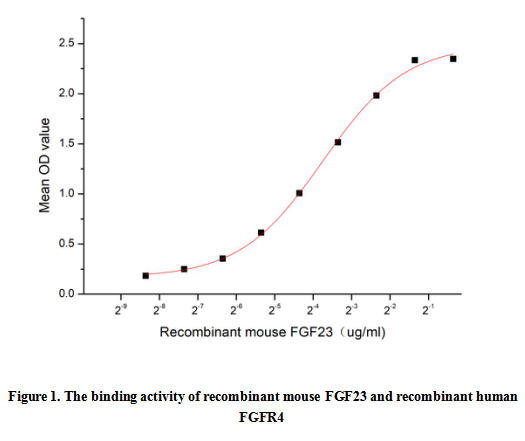Active Fibroblast Growth Factor 23 (FGF23)
ADHR; HYPF; HPDR2; PHPTC; Phosphatonin; Tumor-derived hypophosphatemia-inducing factor
- Product No.UAPA746Mu01
- Organism SpeciesMus musculus (Mouse) Same name, Different species.
- Buffer FormulationPBS, pH7.4, containing 0.01% SKL, 5% Trehalose.
- TraitsFreeze-dried powder
- Purity> 95%
- Isoelectric Point9.8
- ApplicationsCell culture; Activity Assays.
- Download n/a
- UOM 10µg50µg 200µg 1mg 5mg
-
FOB
US$ 94
For more details, please contact local distributors!US$ 234
For more details, please contact local distributors! US$ 468
For more details, please contact local distributors! US$ 1404
For more details, please contact local distributors! US$ 3510
For more details, please contact local distributors!
ACTIVITY TEST of the Active Fibroblast Growth Factor 23 (FGF23)


Fibroblast growth factor 23 (FGF23) is a 30 32 kDa member of the FGF family, within a subfamily that also includes FGF19 and FGF21. FGF23 is produced by osteocytes and osteoblasts in response to high circulating phosphate levels, elevated parathyroid hormone, and circulatory volume loading and it plays a central role in chronic kidney disease-mineral bone disorder and is associated with CKD progression and cardiovascular morbidity. Researches show that FGF23 can directly targets cardiac myocytes via Fibroblast Growth Factor Receptor 4 (FGFR4), thereby inducing hypertrophic myocyte growth and the development of left ventricular hypertrophy (LVH) in rodents. Thus a functional binding ELISA assay was conducted to detect the interaction of recombinant mouse FGF23 and recombinant human FGFR4. Briefly, biotin-linked FGF23 were diluted serially in PBS, with 0.01% BSA (pH 7.4). Duplicate samples of 100 ul were then transferred to FGFR4-coated microtiter wells and incubated for 1h at 37℃. Wells were washed with PBST 3 times and incubation with Streptavidin-HRP for 30min, then wells were aspirated and washed 5 times. With the addition of substrate solution, wells were incubated 15-25 minutes at 37℃. Finally, add 50 µl stop solution to the wells and read at 450 nm immediately. The binding activity of FGF23 and FGFR4 was shown in Figure 1, the EC50 for this effect is 0.074 ug/mL.
USAGE of the Active Fibroblast Growth Factor 23 (FGF23)
Reconstitute in 20mM Tris, 150mM NaCl (pH8.0) to a concentration of 0.1-1.0 mg/mL. Do not vortex.
STORAGE of the Active Fibroblast Growth Factor 23 (FGF23)
Avoid repeated freeze/thaw cycles. Store at 2-8°C for one month. Aliquot and store at -80°C for 12 months.
STABILITY of the Active Fibroblast Growth Factor 23 (FGF23)
The thermal stability is described by the loss rate. The loss rate was determined by accelerated thermal degradation test, that is, incubate the protein at 37°C for 48h, and no obvious degradation and precipitation were observed. The loss rate is less than 5% within the expiration date under appropriate storage condition.
INCREMENT SERVICES
BCA Protein Quantification Kit
Molecular Mass Marker for Protein
Monoclonal Antibody Customized Service
Polyclonal Antibody Customized Service
Protein Activity Test Experiment Service
Electrophoretic Mobility Shift Assay (EMSA) Experiment Service
Buffer
Lentivirus Packaging Experiment Service
Adenovirus Packaging Experiment Service
Real Time PCR Experimental Service
Spike RBD Protein (S-RBD)
Protein G
Protein A
Related products
| Catalog No. | Organism species: Mus musculus (Mouse) | Applications (RESEARCH USE ONLY!) |
| URPA746Mu01 | Recombinant Fibroblast Growth Factor 23 (FGF23) | Positive Control; Immunogen; SDS-PAGE; WB. |
| URPA746Mu03 | Recombinant Fibroblast Growth Factor 23 (FGF23) | Positive Control; Immunogen; SDS-PAGE; WB. |
| UAPA746Mu03 | Active Fibroblast Growth Factor 23 (FGF23) | Cell culture; Activity Assays. |
| URPA746Mu02 | Recombinant Fibroblast Growth Factor 23 (FGF23) | Positive Control; Immunogen; SDS-PAGE; WB. |
| UAPA746Mu01 | Active Fibroblast Growth Factor 23 (FGF23) | Cell culture; Activity Assays. |
| UPAA746Mu02 | Polyclonal Antibody to Fibroblast Growth Factor 23 (FGF23) | WB; IHC; ICC; IP. |
| UPAA746Mu01 | Polyclonal Antibody to Fibroblast Growth Factor 23 (FGF23) | WB |
| UMEA746Mu | Mini Samples ELISA Kit for Fibroblast Growth Factor 23 (FGF23) | Enzyme-linked immunosorbent assay for Antigen Detection. |
| USEA746Mu | ELISA Kit for Fibroblast Growth Factor 23 (FGF23) | Enzyme-linked immunosorbent assay for Antigen Detection. |
| ULMA746Mu | Multiplex Assay Kit for Fibroblast Growth Factor 23 (FGF23) ,etc. by FLIA (Flow Luminescence Immunoassay) | FLIA Kit for Antigen Detection. |
| UKSA746Mu01 | ELISA Kit DIY Materials for Fibroblast Growth Factor 23 (FGF23) | Main materials for "Do It (ELISA Kit) Yourself". |



